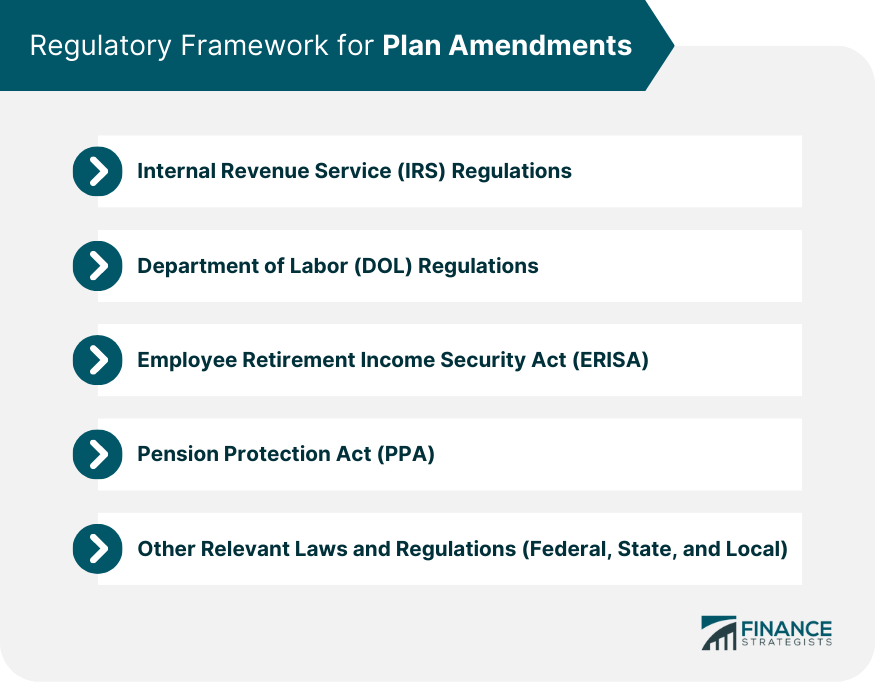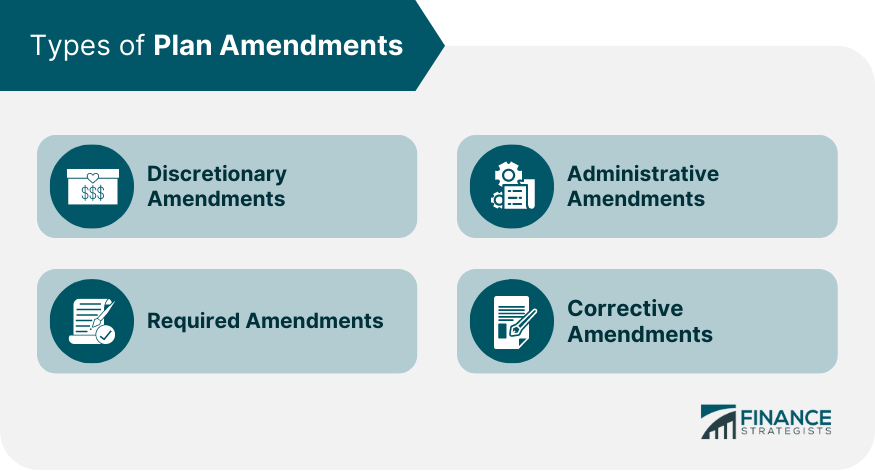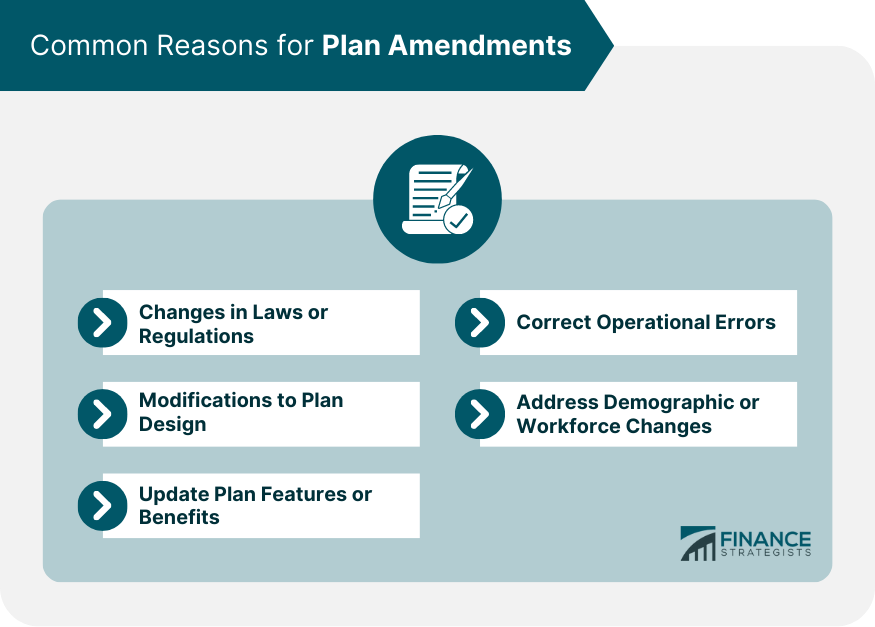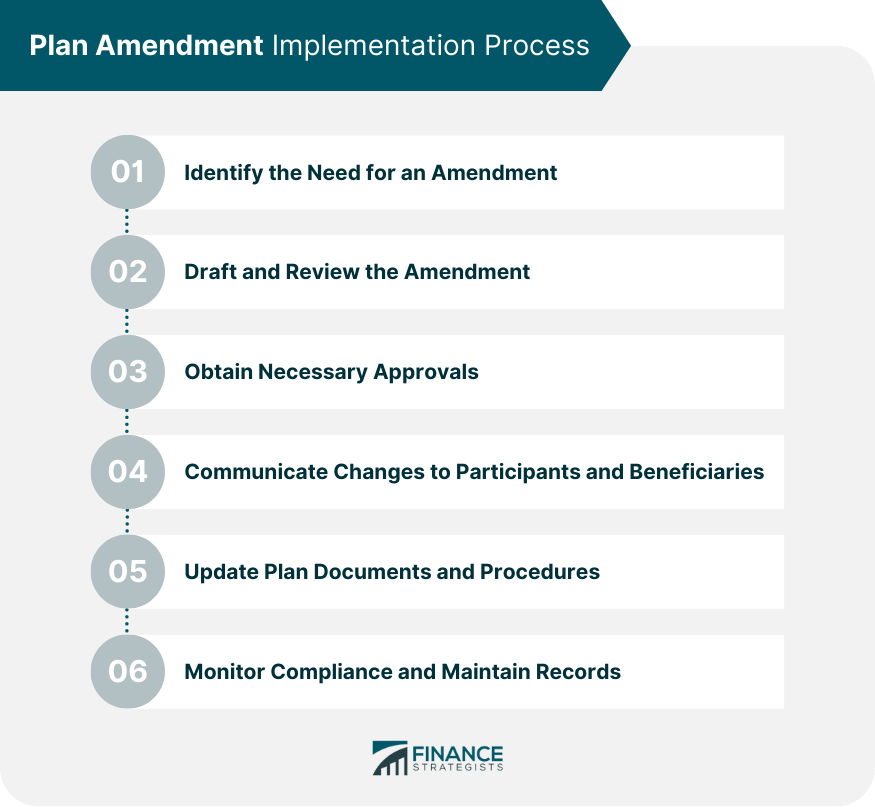A plan amendment refers to any change or modification made to a retirement plan's governing documents, including the plan's provisions, design, or administrative procedures. These amendments may be required to comply with new laws or regulations, correct errors, or update plan features and benefits. Plan amendments are crucial to ensure retirement plans remain compliant with federal laws and regulations. They help plan sponsors and administrators maintain their plans' tax-qualified status, avoid penalties, and protect participants' rights and benefits. The IRS is responsible for overseeing the tax-qualification status of retirement plans. Plan amendments must comply with the Internal Revenue Code (IRC) provisions and applicable regulations to maintain their tax-qualified status. The DOL enforces rules and regulations under the Employee Retirement Income Security Act (ERISA), which governs retirement plan administration and fiduciary responsibilities. Plan sponsors and administrators must ensure that any plan amendments align with ERISA requirements to protect participants' rights and benefits. ERISA establishes minimum standards for retirement plans in the private sector, including reporting and disclosure, participation and vesting, funding, and fiduciary responsibilities. Plan amendments must be consistent with ERISA's provisions to ensure compliance. The PPA is a federal law that strengthens retirement plan funding requirements, enhances disclosure rules, and encourages the use of automatic enrollment features. Plan amendments must adhere to PPA provisions to maintain compliance with this law. In addition to IRS, DOL, ERISA, and PPA requirements, retirement plan amendments may also be subject to other federal, state, and local laws and regulations. Plan sponsors and administrators should consult with legal and tax advisors to ensure comprehensive compliance. Discretionary amendments are voluntary changes made by the plan sponsor to enhance or modify plan features, benefits, or design. These amendments may include changes in contribution or vesting schedules, adding or removing optional features, or updating plan provisions. Required amendments are changes mandated by new laws, regulations, or official guidance from federal agencies. These amendments must be adopted to maintain the plan's tax-qualified status and ensure compliance with relevant legal requirements. Administrative amendments are changes made to clarify plan language, update administrative procedures, or correct typographical errors. These amendments help ensure that plan documents accurately reflect the plan's operation and comply with regulatory requirements. Corrective amendments are changes made to rectify operational errors or other plan failures that could jeopardize the plan's tax-qualified status. These amendments may be required as part of a voluntary correction program or in response to an audit or investigation by the IRS or DOL. Plan sponsors and administrators must regularly review their retirement plans to ensure compliance with any changes in federal, state, or local laws and regulations. Amendments may be necessary to address new legal requirements or guidance. Plan sponsors may decide to amend their retirement plans to better align with their business goals, workforce demographics, or other factors. These amendments may involve changes to plan features, benefits, or eligibility requirements. Amendments may be necessary to update plan features or benefits, such as adding new investment options, incorporating automatic enrollment provisions, or modifying contribution or vesting schedules. Corrective amendments may be required to address operational errors or failures that could jeopardize the plan's tax-qualified status or result in penalties or sanctions. These amendments help bring the plan back into compliance with regulatory requirements and protect participants' rights and benefits. Plan sponsors and administrators may need to amend their retirement plans to adapt to changes in their workforce demographics, employee needs, or industry trends. Amendments may involve adjusting eligibility requirements, offering additional benefits, or updating plan provisions to better serve the needs of their employees. Plan sponsors and administrators must be aware of the deadlines for adopting plan amendments. The deadlines for required amendments are often specified by law or regulatory guidance. For discretionary amendments, plan sponsors should consult with their legal and tax advisors to determine appropriate deadlines. In some cases, plan amendments may be adopted retroactively to correct errors or comply with new legal requirements. Plan sponsors and administrators must ensure that retroactive amendments are permitted under the applicable laws and regulations and are adopted within any specified time frame. Failing to adopt plan amendments within the required deadlines can result in penalties, sanctions, or the loss of the plan's tax-qualified status. Plan sponsors and administrators must be diligent in monitoring deadlines and ensuring the timely adoption of amendments. Plan sponsors and administrators should regularly review their retirement plans to identify any necessary amendments. This may involve monitoring changes in laws and regulations, evaluating plan design and features, and addressing operational errors or other issues. Once the need for an amendment has been identified, plan sponsors and administrators should draft the amendment in consultation with legal and tax advisors. The amendment should be carefully reviewed to ensure accuracy and compliance with all applicable laws and regulations. Depending on the plan's governance structure, certain approvals may be necessary before adopting the amendment. This may involve obtaining approval from the plan sponsor's board of directors, senior management, or other governing bodies. Plan sponsors and administrators must communicate any changes to the plan's provisions or features to participants and beneficiaries, as required by ERISA and other applicable laws. This may involve updating Summary Plan Descriptions, providing individual notices, or conducting employee education sessions. Once the amendment has been adopted, plan sponsors and administrators must update their plan documents and administrative procedures to reflect the changes. This may involve revising the plan's governing documents, updating operational procedures, and ensuring the proper implementation of the amendment. After implementing the amendment, plan sponsors and administrators should monitor ongoing compliance with the amended provisions and maintain records documenting the amendment's adoption and implementation. This may involve periodic compliance reviews, internal audits, or other monitoring activities. Plan sponsors and administrators should conduct regular reviews of their retirement plans to ensure ongoing compliance with all applicable laws and regulations and to identify any necessary amendments. Plan sponsors and administrators must stay informed about changes in laws and regulations that may affect their retirement plans. This may involve subscribing to regulatory updates, participating in industry associations, or attending professional development events. To ensure comprehensive compliance, plan sponsors and administrators should consult with legal and tax advisors when drafting, reviewing, and implementing plan amendments. Plan sponsors should provide ongoing training and education to plan administrators to ensure they understand their responsibilities related to plan amendments and compliance. Plan sponsors and administrators should establish internal controls and checks to monitor compliance with plan amendments, identify issues, and prevent potential errors or failures. This may involve developing compliance checklists, conducting periodic reviews, or implementing automated monitoring systems. Plan sponsors and administrators must be diligent in monitoring amendment deadlines and ensuring the timely adoption of required and discretionary amendments. This may involve creating a calendar of deadlines, assigning responsibility for monitoring deadlines or using project management tools to track amendment progress. Plan amendments are crucial for maintaining retirement plan compliance and ensuring that participants' rights and benefits are protected. Plan sponsors and administrators must be aware of the regulatory framework governing plan amendments and the various types of amendments, including discretionary, required, administrative, and corrective amendments. Common reasons for plan amendments include changes in laws or regulations, modifications to plan design, updating plan features or benefits, correcting operational errors, and addressing demographic or workforce changes. The process for implementing such involves identifying the need for an amendment, drafting and reviewing the amendment, obtaining necessary approvals, communicating changes to participants and beneficiaries, updating documents and procedures, and monitoring compliance. Best practices for plan amendment compliance include regularly reviewing plan documents, keeping up-to-date with regulatory changes, consulting with legal and tax advisors, and training and educating plan administrators. As well as implementing internal controls and checks and ensuring the timely adoption of amendments.Definition of Plan Amendment
Regulatory Framework for Plan Amendments

Internal Revenue Service (IRS) Regulations
Department of Labor (DOL) Regulations
Employee Retirement Income Security Act (ERISA)
Pension Protection Act (PPA)
Other Relevant Laws and Regulations
Types of Plan Amendments

Discretionary Amendments
Required Amendments
Administrative Amendments
Corrective Amendments
Common Reasons for Plan Amendments

Changes in Laws or Regulations
Modifications to Plan Design
Updating Plan Features or Benefits
Correcting Operational Errors
Addressing Demographic or Workforce Changes
Timing and Deadlines for Plan Amendments
Amendment Deadlines
Retroactive Amendments
Consequences of Missed Deadlines
Process for Implementing Plan Amendments

Identifying the Need for an Amendment
Drafting and Reviewing the Amendment
Obtaining Necessary Approvals
Communicating Changes to Participants and Beneficiaries
Updating Plan Documents and Procedures
Monitoring Compliance and Maintaining Records
Best Practices for Plan Amendment Compliance
Regularly Reviewing Plan Documents
Keeping Up-To-Date With Regulatory Changes
Consulting With Legal and Tax Advisors
Training and Educating Plan Administrators
Implementing Internal Controls and Checks
Ensuring Timely Adoption of Amendments
Bottom Line
Plan Amendment FAQs
A plan amendment is a change or modification to a retirement plan's governing documents, provisions, design, or administrative procedures. It is important because it ensures the plan remains compliant with federal laws and regulations, maintains its tax-qualified status, and protects participants' rights and benefits.
There are four main types of plan amendments: discretionary, required, administrative, and corrective. Discretionary amendments are voluntary changes made by the plan sponsor, while new laws or regulations mandate required amendments. Administrative amendments involve clarifying plan language or updating procedures, and corrective amendments address operational errors or plan failures.
Plan sponsors should regularly review their retirement plans to identify any necessary amendments. This may involve monitoring changes in laws and regulations, evaluating plan design and features, and addressing operational errors or other issues. Consulting with legal and tax advisors can also help plan sponsors determine if amendments are needed.
Deadlines for required plan amendments are often specified by law or regulatory guidance. For discretionary amendments, plan sponsors should consult with their legal and tax advisors to determine appropriate deadlines. It is crucial to monitor and adhere to these deadlines, as failing to do so can result in penalties, sanctions, or the loss of the plan's tax-qualified status.
Best practices for plan amendment compliance include regularly reviewing plan documents, staying informed about regulatory changes, consulting with legal and tax advisors, providing ongoing training and education for plan administrators, implementing internal controls and checks, and ensuring timely adoption of amendments. By following these practices, plan sponsors and administrators can maintain compliance with their retirement plans and protect participants' rights and benefits.
True Tamplin is a published author, public speaker, CEO of UpDigital, and founder of Finance Strategists.
True is a Certified Educator in Personal Finance (CEPF®), author of The Handy Financial Ratios Guide, a member of the Society for Advancing Business Editing and Writing, contributes to his financial education site, Finance Strategists, and has spoken to various financial communities such as the CFA Institute, as well as university students like his Alma mater, Biola University, where he received a bachelor of science in business and data analytics.
To learn more about True, visit his personal website or view his author profiles on Amazon, Nasdaq and Forbes.











